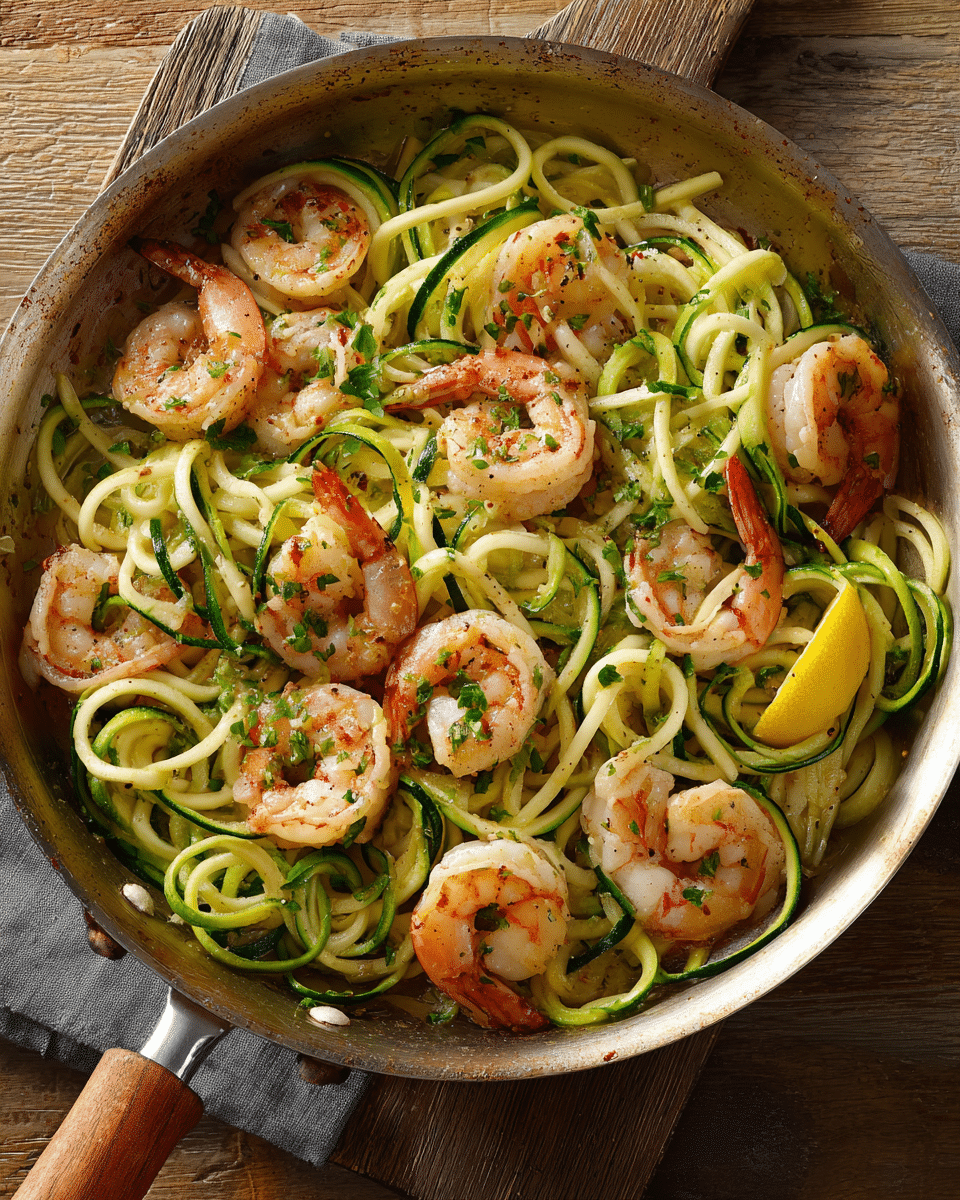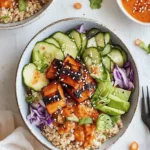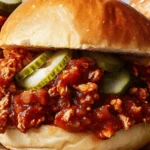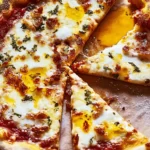Shrimp Zucchini Pasta is a deliciously light, low-carb alternative to traditional pasta dishes. Featuring fresh zucchini spirals in place of noodles and juicy shrimp sautéed in garlic and olive oil, this recipe is perfect for anyone seeking a healthier yet satisfying dinner option. With its combination of lean protein and vegetables, this dish is quick to prepare and brimming with savory, Mediterranean-inspired flavors.
FULL RECIPE
Ingredients
- 1 tablespoon olive oil
- 1 pound medium shrimp, peeled and deveined
- 3 medium zucchini, spiralized
- 3 cloves garlic, minced
- 1/2 teaspoon red pepper flakes (optional)
- 1/2 teaspoon sea salt
- 1/4 teaspoon black pepper
- 1/2 teaspoon lemon zest
- 1 tablespoon lemon juice
- 1/4 cup grated Parmesan cheese (optional)
- 2 tablespoons fresh parsley, chopped
Directions
- Heat olive oil in a large skillet over medium-high heat.
- Add shrimp in a single layer and cook for about 2 minutes per side or until pink and opaque. Remove shrimp from skillet and set aside.
- In the same skillet, add garlic and red pepper flakes (if using). Sauté for 30 seconds until fragrant.
- Add zucchini noodles, salt, and black pepper. Toss gently and cook for 2–3 minutes until just tender but still slightly crisp.
- Return shrimp to the skillet. Add lemon zest and lemon juice. Toss to combine everything evenly and heat through.
- Remove from heat and sprinkle with Parmesan cheese and chopped parsley, if desired.
- Serve immediately while warm.
Nutrition Facts
- Calories: 220
- Protein: 24g
- Fat: 10g
- Saturated Fat: 2g
- Carbohydrates: 6g
- Fiber: 2g
- Sugars: 4g
- Sodium: 580mg
- Cholesterol: 180mg
Health Benefits of Shrimp Zucchini Pasta
Shrimp Zucchini Pasta is a powerhouse of nutrition while remaining low in carbs and calories. Shrimp is rich in high-quality protein and provides a significant source of omega-3 fatty acids, selenium, and vitamin B12—all essential nutrients for maintaining energy, metabolism, and immune support. Zucchini, on the other hand, is low in calories yet high in fiber, vitamin C, and potassium. Together, they form a meal that supports weight management, muscle recovery, and heart health without compromising on taste or satisfaction.
Low-Carb and Keto-Friendly Qualities
For individuals following a ketogenic or low-carb lifestyle, Shrimp Zucchini Pasta is an excellent meal choice. By substituting traditional pasta with spiralized zucchini, the recipe drastically reduces carb content while still providing a satisfying noodle-like experience. This not only helps keep blood sugar levels stable but also aligns with dietary goals such as fat loss or improved insulin sensitivity. The addition of healthy fats from olive oil and optional Parmesan cheese further supports the nutritional needs of low-carb eaters.
Flavor Profile and Seasoning Choices
One of the standout features of this dish is its bold and balanced flavor. The natural sweetness of shrimp pairs beautifully with the mild, slightly nutty taste of zucchini. Garlic adds depth and savoriness, while lemon zest and juice introduce brightness and acidity that lift the dish. For those who enjoy a little kick, red pepper flakes provide optional heat. Parmesan cheese, when used, adds a salty, umami-rich note that enhances the overall complexity. These elements work in harmony, making each bite refreshing and layered.
Customization and Variations
Shrimp Zucchini Pasta is highly adaptable to different tastes and dietary needs. For a creamier version, a splash of heavy cream or coconut milk can be stirred in toward the end of cooking. Vegetarians can substitute shrimp with sautéed mushrooms or tofu for a satisfying alternative. To introduce more color and nutrition, consider adding cherry tomatoes, baby spinach, or bell peppers. For those not avoiding carbs entirely, a half-and-half mix of zucchini noodles and whole wheat pasta can create a more traditional texture while still lightening the meal.
Meal Prep and Storage Tips
This recipe is ideal for meal prep, especially for busy weeknights. While shrimp is best served fresh, it can be cooked in advance and stored in an airtight container in the refrigerator for up to 2 days. Zucchini noodles, however, release water over time, so it’s recommended to store them separately and combine them with reheated shrimp just before serving. To prevent sogginess, avoid overcooking the zucchini when reheating. The cooked dish can be kept in the fridge for up to 3 days, but it is not recommended for freezing due to texture changes in both shrimp and zucchini.
Ideal Pairings and Serving Suggestions
To round out the meal, consider serving Shrimp Zucchini Pasta with a fresh green salad dressed in a lemon vinaigrette, which complements the citrus notes in the dish. A side of roasted asparagus or steamed broccoli adds extra fiber and visual appeal. For a more indulgent approach, pair with low-carb garlic bread or almond flour biscuits. A crisp white wine such as Sauvignon Blanc or Pinot Grigio also works well with the light and lemony flavors of the dish, offering a refreshing contrast to the savory elements.
Cooking Tools and Equipment
Making Shrimp Zucchini Pasta is simple, but the right tools can elevate the cooking experience. A high-quality spiralizer is essential for turning zucchini into consistent, spaghetti-like strands. A large nonstick or stainless-steel skillet allows for even heat distribution, ensuring the shrimp cook quickly and evenly without sticking. Tongs are useful for tossing the zucchini noodles gently to maintain their shape and texture. Having a microplane for zesting lemons and a sharp knife for preparing ingredients will also save time and enhance precision.
Tips for Perfect Zucchini Noodles
Zucchini noodles, often called “zoodles,” require careful handling to avoid becoming watery or mushy. After spiralizing, it’s helpful to pat them dry with paper towels or let them sit in a colander with a bit of salt for 10 minutes to draw out excess moisture. When cooking, sauté them briefly—usually no more than 2 to 3 minutes—so they stay crisp-tender. Avoid covering the skillet while cooking, as trapped steam can make them soggy. Cooking them separately and combining with the shrimp just before serving helps retain the best texture.
Sustainability and Seafood Choices
Using sustainably sourced shrimp can make this dish more environmentally responsible. Opting for wild-caught or responsibly farmed shrimp supports eco-friendly practices and ensures fewer contaminants. Reading labels or purchasing from trusted seafood vendors can make a significant difference. Shrimp is also one of the more affordable types of seafood, making it an accessible protein option for home cooks looking to incorporate more seafood into their diets without compromising quality or ethics.
Dietary Accommodations and Allergen Notes
This recipe is naturally gluten-free and can be made dairy-free by omitting Parmesan or substituting it with a dairy-free alternative. It’s also nut-free and suitable for pescatarians. For those sensitive to shellfish, shrimp can be swapped for chicken breast or a plant-based protein like tempeh. Adjusting the spice level is simple—just omit the red pepper flakes for a milder version. Because it relies on whole, fresh ingredients, this dish is easy to tailor to individual dietary restrictions or preferences without sacrificing flavor.
Conclusion
Shrimp Zucchini Pasta is more than just a low-carb alternative to traditional pasta—it’s a wholesome, versatile, and flavor-packed dish suitable for a variety of lifestyles and occasions. With its lean protein, vibrant vegetables, and zesty accents, it brings together the best of healthy eating and satisfying comfort food. Whether you’re looking to lighten up your dinner routine, follow a keto-friendly meal plan, or simply explore new recipes, this dish delivers taste and nutrition in every bite. Its ease of preparation and potential for customization make it a staple worth returning to time and again.






